(1983) Written and directed by Philip Kaufman; Based on the
book The Right Stuff by Tom Wolfe; Starring: Sam Shepard, Scott Glenn, Ed
Harris, Barbara Hershey, Dennis Quaid, Fred Ward, Veronica Cartwright, Lance
Henriksen, Harry Shearer and Jeff Goldblum; Available on Blu-ray and DVD
Rating: *****
“I wanted to make a film about – where the main character was something called ‘The Right Stuff.’ It was a quality that was mysterious, that manifested itself in every scene of the film. It was sort of a spirit…” – Philip Kaufman (from 2020 interview at Cinémathèque – Paris)
First of all, a big thanks to Rebecca from Taking Up Room for hosting the Aviation in Film Blogathon, a celebration of flight and flicks. This week, I take a look at one of my unabashed favorites, The Right Stuff. While I don’t have an official top ten list of all-time favorite movies, if I did, this would certainly occupy a spot.
Writer/director Philip Kaufman handled the unenviable task
of adapting Tom Wolfe’s captivating book (serialized in Rolling Stone magazine),
which chronicled the story of the original Mercury 7 astronauts, along with the
test pilots who crawled so they could run. Kaufman keeps many threads running
throughout his film, and does an admirable job of avoiding them getting
tangled. Much more than a stuffy chain of events, The Right Stuff focuses
on some of the many unique, colorful individuals who made space flight possible.
Levon Helm’s folksy narration bookends the film, evoking images of the Old West,
as it relates to the unexplored frontier of space.
Set amidst the backdrop of the Cold War, the U.S. and U.S.S.R. were engaged in a battle for supremacy of the skies: the Space Race. Despite America’s supposed technical superiority over Russia (One NASA engineer remarks, “Our Germans are better than their Germans.”), they lag behind the achievements of the Soviets, with Sputnik and Yuri Gagarin. The desperate urgency to catch up is encapsulated by a hilarious and horrifying montage of failed rocket tests. Considering the risks and rewards involved, the freshly minted astronaut program required a new type of person.
Two parallel stories run throughout the film – It’s as much about test pilot Chuck Yeager (expertly portrayed by actor/playwright Sam Shepard)*/** as it is about the Mercury 7 astronauts. Kaufman’s wife reportedly spotted Shepard in a bar, and insisting that he was perfect for the role. While Shepard was reluctant to play Yeager at first, Kaufman persisted in pursuing him until he eventually settled into the role. In retrospect, Shepard was the ideal choice. Yeager anchors the film, with his “can do” attitude and no-nonsense approach. Yeager’s laid-back, fearless persona belies the nature of his extremely hazardous profession, typified by a high pilot mortality rate (The ominous presence of a minister, played by Royal Dano, looms like a harbinger of death throughout the film). The film begins in 1947, when Yeager breaks the sound barrier in his rocket-powered Bell X-1, nicknamed “Glamorous Glennis,” after his wife (played by Barbara Hershey). While he paved the way for the astronauts, he wasn’t considered a suitable candidate, because he didn’t fit NASA’s profile, which required a college degree. Instead, he carries on as he always had, stretching the capabilities of experimental aircraft. In a climactic scene, pursuing the elusive world altitude record in a souped-up F-104 Starfighter, he briefly reaches the edge of space, before hurtling down in an uncontrolled spin. At once, the scene signifies his determination to push the boundaries, as well as a reminder that for him, space remains just out of reach.
* Fun Fact #1: The real Chuck Yeager served as a technical consultant, and appeared in the film as a bartender at Pancho’s, a favorite hangout for test pilots at Edward’s Air Force Base.
* Fun Fact #2: According to Kaufman, Yeager and Shepard didn’t initially hit it off (Yeager reportedly told the director, “This guy ain’t me.”), but eventually became friends during the production. On the other hand, Yeager took an instant shine to Barbara Hershey, who portrayed his wife, Glennis, referring to her by character’s name.
** Fun Fact #3: Beeman’s Gum is featured prominently in the
film, as Yeager reportedly chewed a stick during each flight. Besides being a
favorite of pilots, the gum originally contained pepsin, which allegedly calmed
the stomach.
Before they ever flew into space, the Mercury 7 astronauts already enjoyed their celebrity status, to varying degrees. Scott Glenn portrays Alan Shepard who enjoys a good joke, but is nothing but serious when it comes to his profession. The late, great Fred Ward excels as gruff Virgil I. “Gus” Grissom, proving number two is the worst spot. After the fanfare and celebration following Shepard’s flight, Grissom’s ends in near disaster when the hatch on his capsule blows prematurely. Instead of a ticker tape parade or a meeting with the President, he’s treated to an inquiry by doubting NASA officials. Ed Harris’ charismatic interpretation of John Glenn* comes across as an overgrown yet amiable boy scout (part of Kaufman’s direction to Harris – smile more), giving us a hint of the astronaut who would become a politician. Gordon Cooper (Dennis Quaid) comes across as a cocky goofball, with a tendency to sleep when things are at their most tense.
* Fun Fact #4: According to co-producer Robert Chartoff, “Ed
Harris walked into the office, and we looked at him and couldn’t believe that
such a person existed. He was not only a wonderful actor but looked so much
like John Glenn. And of course we looked at each other and said, ‘Oh my God,
this is the guy we want.’ I said to Phil (Kaufman), ‘Please, don’t let this guy
get hit by a car. At least, not until after the picture is made.’” (Excerpt
from Wired.com article)
In one key scene, the pressures of being in the public eye
reach a boiling point as the astronauts argue with each other about their
responsibility as role models, versus how they conduct their private lives. Shepard
and Glenn almost come to blows over their difference of opinion, but just as
things are about to get out of hand, they find a united cause. NASA wants to send
a chimp up in space, and it becomes clear to the astronauts that they’re held
in the same regard. It all comes to a head when they confront the arrogant NASA
engineers, who view the astronauts as nothing more than an occupant in a
remote-controlled vehicle of their design (“a redundant component”). As pilots,
the astronauts scrutinize the prototype capsule with skepticism (windowless,
with no hatch they can open from the inside, or control in the event of a
system failure). It’s a clash between the hands-on, practical approach of the
astronauts (“We want a window.”) and the arrogant, book-smart engineers (“This
is the way it is.”).
Amidst the drama, there are so many terrific comic moments. Harry Shearer and Jeff Goldblum (who largely improvised their lines), appear as two bumbling government recruiters, who court test pilots for the hazardous job. After his launch is delayed for hours, and he’s bolted into his cockpit, Alan Shepard declares that he has to urinate. Unfortunately for Shepard, no one considered this contingency for a supposed 15-minute flight, which sparks a fierce debate between the engineers and astronauts about what peeing in his spacesuit might do to his spacecraft. In an earlier scene, also with Shepard, he’s confronted by a Latino orderly with the ramifications of using a racist impression during a particularly vulnerable moment.
Kaufman had such a monumental task balancing Yeager’s story, with the ensemble work of the seven astronauts that it’s inevitable some of the Mercury 7, notably Scott Carpenter (Charles Frank), Wally Schirra (Lance Henriksen), and Deke Slayton (Scott Paulin) are relegated more to the background (for more on these three, I suggest checking out Wolfe’s book). While Kaufman spends significantly less time on the wives of the astronauts, the actresses’ performances shine through, speaking to the wives’ strength and resolve in the face of uncertainty. Trudy Cooper (Pamela Reed) reaches her wit’s end, following her husband Gordon from base to base, and remaining forever in his shadow. John Glenn’s wife Annie (Mary Jo Deschanel) refuses to appear on national TV with Vice President Lyndon Johnson (Donald Moffat), due to a stutter (much to the indignation of Johnson). Veronica Cartwright (as Betty Grissom) shares one of the film’s most heart-wrenching scenes with Fred Ward, sharing their anguish and bitterness about their unfair treatment by NASA officials.
So what exactly is “The Right Stuff?” It’s that indefinable quality to push the envelope,* and embrace a challenge rather than step away from it. Just because so-called experts said breaking the sound barrier couldn’t be done, didn’t mean that it was an impossible task for Yeager. It’s unwavering resolve under pressure when most individuals would give up – a reliance on wits and fearlessness. A common trait found among Yeager and the astronauts is that they’re all adrenaline junkies, driven to be the best and the fastest (Gordon Cooper asks his wife, “Who’s the best pilot you ever saw,” and subsequently answers his own question. “You’re looking at him.”) In an early scene, the NASA recruiters invite Scott Carpenter to consider joining their dangerous program, which prompts the response, “Count me in.” When John Glenn is informed that his Mercury spacecraft will be launched by the more powerful, albeit unpredictable Atlas rocket, he doesn’t hesitate to step up to the challenge.
* Not so Fun Fact: Unfortunately, during filming, Joseph
Svec, a stuntman, was killed filming a parachute drop, when his chute failed to
open.
The excellent performances are matched by the brilliance of the
visuals, thanks to cinematographer Caleb Deschanel’s superb camerawork and
effects supervised by Gary Gutierrez. The action sequences are kinetic and
visceral, punctuated with moments of visual poetry. The sound barrier is
imagined as a demon that lives in the sky. A deftly applied mixture of editing,
effects and photography place us squarely in the cramped cockpit of the X-1
with Chuck Yeager. Sparks in the Australian outback are juxtaposed with
mysterious “fireflies” that surround John Glenn’s capsule, Friendship 7. The
most iconic shot of the film is a slow-motion sequence, depicting the Mercury 7
astronauts walking side-by-side in full gear, which has been copied and
parodied in countless movies (think Monsters, Inc.).
* Fun Fact #5: According to Kaufman, there were 134 speaking parts.
Sources: “Punch a Hole in the Sky: An Oral History of TheRight Stuff,” by Alex French and Howie Kahn, Wired.com; Interview with Philip Kaufman at Cinémathèque – Paris, 2020

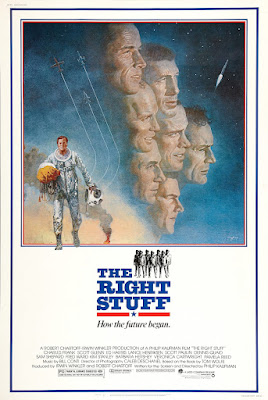

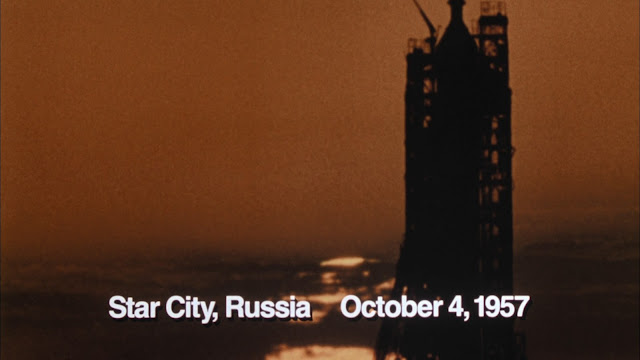

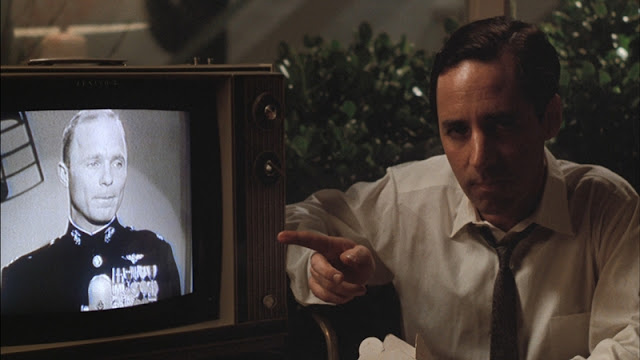
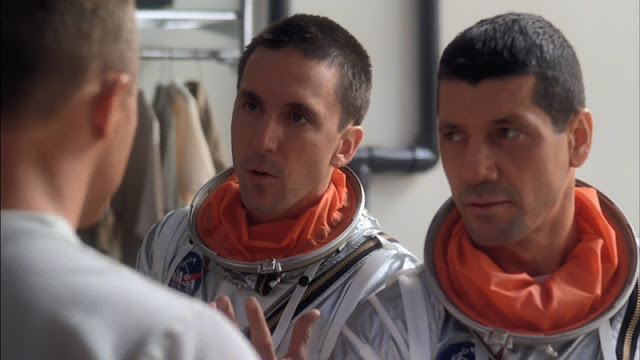



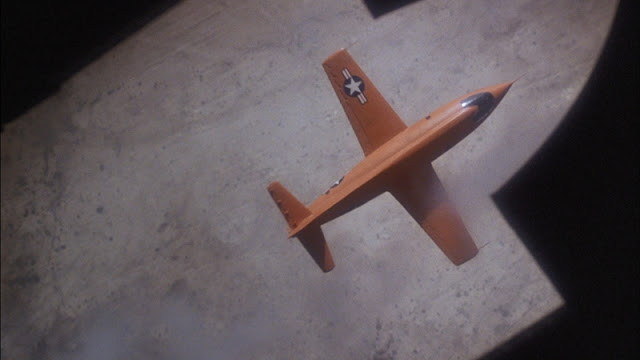

I completely concur with everything in this movie--it's incredible. Some of the scenes look like paintings. I liked the way the communicated the changing of the guard with the bar burning down and Yaeger having to bail out. It's subtle but it says so much. Thanks again for joining the blogathon, Barry--this was awesome!
ReplyDeleteThanks again for hosting such a great blogathon, Rebecca! It was the perfect excuse to write about one of my favorites! :)
DeleteA great review of a great film. Thank you for posting it!
ReplyDeleteThank you very much! :)
DeleteGreat pick Barry! I've been a space nut for as long as I can remember, and naturally I read Wolfe's book when it came out and was super excited by the film. You're absolutely right - it's that rare 3+ hour movie where in retrospect, you couldn't think of a single thing to cut. And that cast! There are so many authentic, human moments. You're spot on with the line that it "de-mythologizes the astronauts as it preserves the mythos surrounding them." You've got the movie review right stuff! :)
ReplyDeleteThank you, sir! This movie pushes all the right buttons. I don't know what kind of alchemy Kaufman managed, to bring all the elements together, but it certainly worked. An astonishing achievement. It's been many moons since I've read the book, but I think a re-read is in my future.
Delete